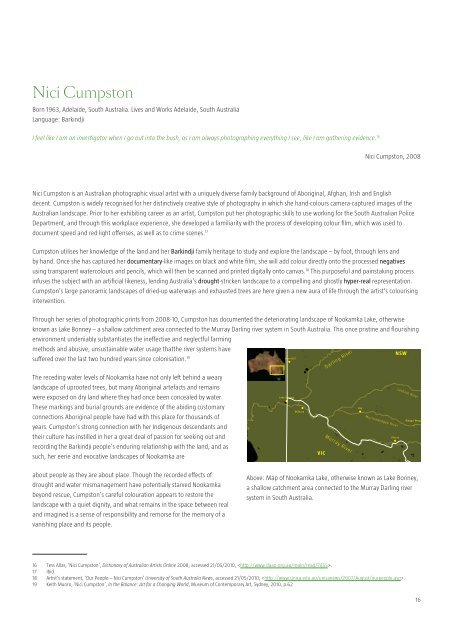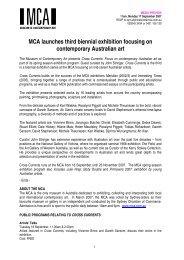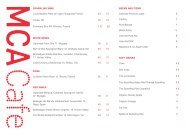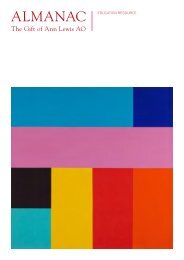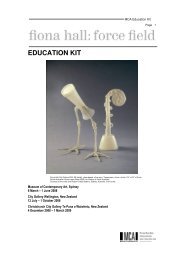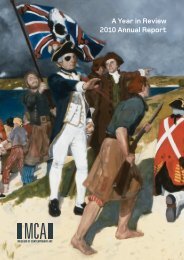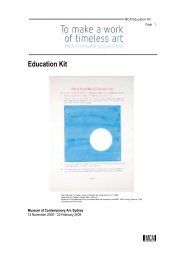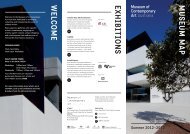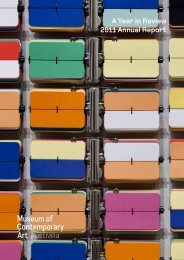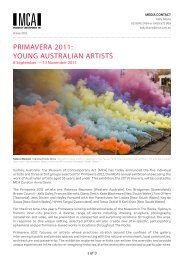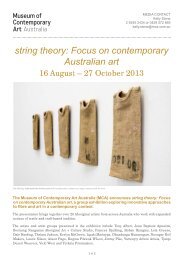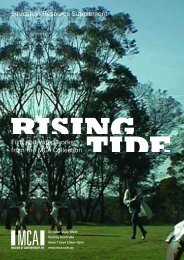Download - Museum of Contemporary Art
Download - Museum of Contemporary Art
Download - Museum of Contemporary Art
Create successful ePaper yourself
Turn your PDF publications into a flip-book with our unique Google optimized e-Paper software.
Nici Cumpston<br />
Born 1963, Adelaide, South Australia. Lives and Works Adelaide, South Australia<br />
Language: Barkindji<br />
I feel like I am an investigator when I go out into the bush, as I am always photographing everything I see, like I am gathering evidence. 16<br />
Nici Cumpston, 2008<br />
Nici Cumpston is an Australian photographic visual artist with a uniquely diverse family background <strong>of</strong> Aboriginal, Afghan, Irish and English<br />
decent. Cumpston is widely recognised for her distinctively creative style <strong>of</strong> photography in which she hand-colours camera-captured images <strong>of</strong> the<br />
Australian landscape. Prior to her exhibiting career as an artist, Cumpston put her photographic skills to use working for the South Australian Police<br />
Department, and through this workplace experience, she developed a familiarity with the process <strong>of</strong> developing colour film, which was used to<br />
document speed and red light <strong>of</strong>fenses, as well as to crime scenes. 17<br />
Cumpston utilises her knowledge <strong>of</strong> the land and her Barkindji family heritage to study and explore the landscape – by foot, through lens and<br />
by hand. Once she has captured her documentary-like images on black and white film, she will add colour directly onto the processed negatives<br />
using transparent watercolours and pencils, which will then be scanned and printed digitally onto canvas. 18 This purposeful and painstaking process<br />
infuses the subject with an artificial likeness, lending Australia’s drought-stricken landscape to a compelling and ghostly hyper-real representation.<br />
Cumpston’s large panoramic landscapes <strong>of</strong> dried-up waterways and exhausted trees are here given a new aura <strong>of</strong> life through the artist’s colourising<br />
intervention.<br />
Paroo River<br />
Warrego River<br />
Culgoa River<br />
MacIn<br />
Through her series <strong>of</strong> photographic prints from 2008-10, Cumpston has documented the deteriorating landscape <strong>of</strong> Nookamka Lake, otherwise<br />
known as Lake Bonney – a shallow catchment area connected to the Murray Darling river system in South Australia. This once pristine Bourke and flourishing<br />
environment undeniably substantiates the ineffective and neglectful farming<br />
Wilcannia<br />
methods and abusive, unsustainable water usage thatthe river systems have<br />
NSW<br />
suffered over the last two hundred years since colonisation. 19<br />
Bourke<br />
Broken Hill<br />
The receding water levels <strong>of</strong> Nookamka have not only left behind a weary<br />
landscape <strong>of</strong> uprooted trees, but many Aboriginal artefacts and remains<br />
were exposed on dry land where they had once been concealed by water.<br />
These markings and burial grounds are evidence <strong>of</strong> the abiding customary<br />
connections Aboriginal people have had with this place for thousands <strong>of</strong><br />
years. Cumpston’s strong connection with her Indigenous descendants and<br />
their culture has instilled in her a great deal <strong>of</strong> passion for seeking out and<br />
recording the Barkindji people’s enduring relationship with the land, and as<br />
such, her eerie and evocative landscapes <strong>of</strong> Nookamka are<br />
Adelaide<br />
SA<br />
Adelaide<br />
SA<br />
Lake Bonney<br />
Broken Hill<br />
Lake Bonney<br />
Mildura<br />
Mildura<br />
Wilcannia<br />
VIC<br />
VIC<br />
Darling River<br />
Darling River<br />
Murray River<br />
Paroo River<br />
Hay<br />
Murray River<br />
Hay<br />
Warrego River<br />
Murrumbidgee River<br />
Murrumbidgee River<br />
Albury<br />
NSW<br />
Lachlan River<br />
Wagga Wagga<br />
Culgoa River<br />
Albury<br />
Lachlan River<br />
Cowra<br />
MacIntyre River<br />
Boggabilla<br />
Toomelah<br />
Wagga Wagga<br />
Cowra<br />
Sydney<br />
about people as they are about place. Though the recorded effects <strong>of</strong><br />
drought and water mismanagement have potentially starved Nookamka<br />
beyond rescue, Cumpston’s careful colouration appears to restore the<br />
landscape with a quiet dignity, and what remains in the space between real<br />
and imagined is a sense <strong>of</strong> responsibility and remorse for the memory <strong>of</strong> a<br />
vanishing place and its people.<br />
Above: Map <strong>of</strong> Nookamka Lake, otherwise known as Lake Bonney,<br />
a shallow catchment area connected to the Murray Darling river<br />
system in South Australia.<br />
16 Tess Allas, ‘Nici Cumpston’, Dictionary <strong>of</strong> Australian <strong>Art</strong>ists Online 2008, accessed 21/05/2010, .<br />
17 Ibid.<br />
18 <strong>Art</strong>ist’s statement, ‘Our People – Nici Cumpston’ University <strong>of</strong> South Australia News, accessed 21/05/2010, .<br />
19 Keith Munro, ‘Nici Cumpston’, In the Balance: <strong>Art</strong> for a Changing World, <strong>Museum</strong> <strong>of</strong> <strong>Contemporary</strong> <strong>Art</strong>, Sydney, 2010, p.62<br />
16


